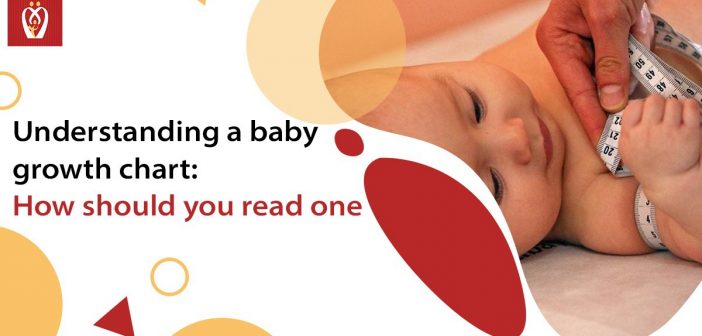Although you don’t need a chart to notice how well your baby is developing, baby growth charts serve as a standard reference for your child’s paediatrician.
At every well-child visit, there’s one thing you can count on: Your child will be measured and weighed. The paediatrician will then record these measures on a baby growth chart, which will allow you to track your child’s growth over time compared to national averages.
Although your child’s paediatrician will be on the watch for any significant rises or declines in a short amount of time, know that having a less-than-average development curve is generally perfectly normal.
What is the purpose of a baby growth chart?
A baby growth chart is exactly what it sounds like: a graph that shows a baby’s development over time compared to other babies.
Since 1977, baby growth charts have been used to track the development of babies. The charts we use today were created by the World Health Organization (WHO) and the Centers for Disease Control and Prevention (CDC). In 2000, the CDC baby growth charts were revised after measuring and weighing thousands of children from different cultures and ethnicities to establish averages for weight, height, and head circumference for boys and girls during infancy and childhood.
These graphs are used to keep track of your child’s measurements and compare them to standard averages to see how they’re progressing over time. Remember that what’s “normal” from newborn to baby might vary dramatically depending on genetics, environment, dietary intake, and activity level.
What exactly do baby growth charts track?
Weight is determined in pounds and ounces after removing your baby’s clothing (they can wear a clean, dry diaper or not) and placing them on the baby scale.
For children under the age of two, length (height) is measured with a tape measure while the child is lying down to stretch her out fully; for children aged two and up, height is measured while standing up.
Wrapping a tape measure around a baby’s head measures head circumference.
Your baby’s paediatrician will plot your child’s measurements on a growth curve at each appointment to track her progress over time. Boys and girls will be measured using different baby growth charts because their growth patterns and rates differ.
How do you understand a baby growth chart for a baby?
These graphs can be difficult to understand! Begin by measuring your baby’s length, weight, or head circumference along one axis. Then, on the other axis, find her age. Follow both of them in a straight line until they meet in the grid’s middle. This will give you your baby’s percentile growth.
When looking at a baby growth chart, focus less on a single metric and more on your child’s curve over time and whether or not it’s consistent.
Here’s everything you need to know about each data point.
Charts of weight gain
Infancy is the time when children gain the most weight. Between the ages of 4 and 6, most kids double their birth weight, and by the period of a year, they have tripled it.
Between the ages of one and two, everything begins to slow down.
Because they’re more active and don’t eat as often, babies grow only approximately 5 pounds during this time. However, between the ages of 2 and 5, most children continue to gain weight at this rate.
If your child’s weight falls into a high percentile:
Perhaps your infant has always been on the larger side, or one or both parents have larger bodies. In any case, this is probably nothing to be concerned about. During the checkup, your baby’s physician will look for indicators of medical issues. Still, if none are identified, the doctor will generally only keep an eye on your child’s weight at subsequent visits.
If your kid has gained a lot of weight in a short period, you should:
You don’t want to put a baby on a diet (babies need calories and fat), but your doctor may ask if you’re overfeeding her. Keeping your child from gaining too much weight is the goal, not losing weight. You can discuss how much and how often you should feed her and how to prevent overfeeding.
If your child has lost a significant amount of weight since her last checkup, you should:
The doctor will most likely inquire about her nutrition (what she eats and how much), as well as any previous health issues (such as persistent vomiting or diarrhoea), and, of course, perform a physical examination. This will assist the paediatrician in determining if a problem is causing the weight loss and, if so, working with you to resolve it.
Graphs of head circumference
Your baby’s paediatrician wants to make sure that their brain grows and develops typically, and head size is a big part of that. The head doesn’t create much more after the fontanelles (soft spots) close at roughly 18 months. However, clinicians still measure head circumference in children up to two (sometimes even until age 3). Again, head size is primarily determined by genetics, so if you or your child’s other parent has a small head, your child may have one as well, and vice versa.
A nurse will tie a flexible measuring tape over the broadest portion of your baby’s forehead, just above the ears, and at the midway of the back of the head to measure your baby’s head.
During the physical exam, the doctor will search for developmental delays or illness symptoms if your baby’s head is much larger or smaller than it was at the previous appointment (just as in any checkup). If everything looks to be in order, the paediatrician will most likely take no action right away and will instead wait until your next appointment to check on your child’s growth.
However, if your child’s percentile is causing your paediatrician concern at the next visit, it may be time to look at the following (rare) scenarios:
If your baby’s head is huge, you should:
The doctor may order a CT scan or an ultrasound to check for hydrocephalus (extra fluid surrounding the brain).
If your baby’s head is small or not growing, you should:
Failure to thrive (when a child doesn’t get enough calories or is unable to use them and, as a result, doesn’t grow appropriately) may be a concern for your baby’s doctor. However, your baby’s paediatrician is much more likely to notice a decline in weight and length on your child’s growth charts before noticing the decrease in head percentile. Small head size or lack of growth can also indicate brain abnormalities in scarce circumstances, albeit rare.
Baby Growth charts for length
The first year of a baby’s life is when they grow the fastest, with an average length of 10 inches. After the age of one, children’s growth slows, and from the age of two to adolescence, children typically grow about 2 1/2 inches per year.
The paediatrician’s office nurse will gently stretch your baby out on the exam table to measure her length from the top of her head to the bottom of her heel. Because your baby may fidget or scrunch up her legs during the measurement, length is the least reliable of all the baby growth chart measurements recorded at your child’s checkups.
If your baby is growing in length and weight at each session, you can:
- This is because they’re getting enough calories and are gaining weight usually.
- If your kid measures very long and gains weight quickly, you may be feeding them too much and too often. Your doctor will discuss your baby’s eating patterns with you and, if required, provide advice on avoiding overfeeding (for example, learning to read your baby’s hunger cues and not allowing her to use your breast as a pacifier if you’re breastfeeding).
If your child has always been on the short end of the spectrum:
- Your baby’s length percentiles may be small as well if you or the other parent (or both) are petite.
- If your kid isn’t growing in length or weight (or is growing at a snail’s pace):
- They could fail to thrive, which occurs when your baby doesn’t get enough calories or their body can’t use the calories she needs to grow. Failure to thrive can have a variety of causes, so if your doctor detects it, the next step is to figure out what’s causing it and then treat it.
When should I be concerned about my baby’s development?
It’s critical not to compare your child to others. There’s usually no reason to be concerned as long as she’s growing gradually on her curve. Her growth trend will slow down after the first year.
You, on the other hand, are the most knowledgeable about your child. Consult your child’s paediatrician you have any concerns regarding her development.




